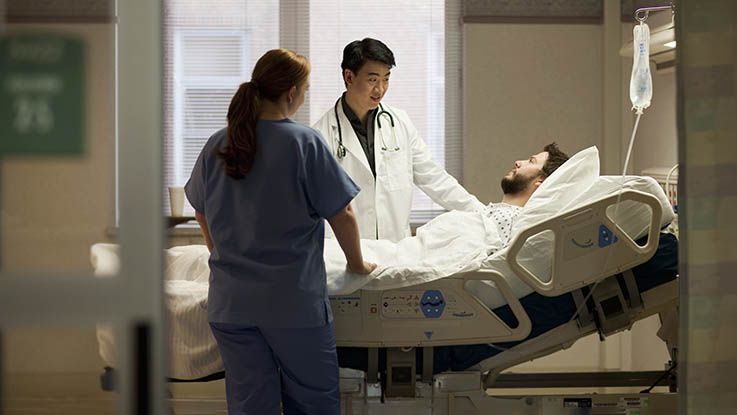How we use skin graft surgery for severe burns
After a minor burn or small wound, the skin is able to heal on its own. The skin can make new skin cells to replace the damaged tissue. But after a severe burn, the skin usually needs some help to heal.
Skin grafts are used to treat severe burns by placing healthy skin tissue over damaged areas. When the skin can’t make new cells on its own, skin grafts can help you heal as quickly as possible.
At the Regions Hospital Burn Center, our burn experts have performed thousands of skin grafts to help patients of all ages recover from burns. From the minor to the most complex skin graft surgery, we’ll be able to treat your wound with as little scarring as possible.

What is a skin graft?
A skin graft is a surgical procedure where we take a piece of healthy skin and attach it to an area of burned skin that has been excised (cleaned). While first-degree (superficial) burns heal naturally, more severe burns require skin grafts.
Deep second-degree burns and third-degree (full thickness) burns aren’t able to naturally replace damaged skin cells on their own. Skin graft surgery enables these severe types of burns to heal quickly and with minimal scarring.
Types of skin grafts
Some of the different types of skin grafts are allografts, xenografts, autografts and synthetic skin substitutes. We use skin grafts temporarily and permanently, depending on the needs of the patient.
Temporary burn wound coverings
Temporary skin grafts can be used until the
We use two types of temporary skin grafts: allografts and xenografts.
Allograft
An allograft, also known as cadaver skin or homograft, is human cadaver skin donated for medical use. Cadaver skin is used as a temporary covering for excised wound surfaces before a permanent covering can be used.
Xenograft
A xenograft, also known as heterograft, is a skin graft taken from a variety of animals, usually a pig. Heterograft skin became popular because of the limited availability and high expense of human skin tissue.
Wound coverage using heterograft is a temporary covering used until an autograft is available.
Permanent burn wound coverings
When we need to cover your burn wound permanently with a skin graft, we use autografts and synthetic skin grafts.
Autograft
An autograft is skin taken from the person burned. Because the skin is a major organ in the body, an autograft is essentially an organ transplant.
The autograft is surgically removed using a dermatome (a tool with a sharp razor blade). Only the top layer of skin is used for donor skin, and the site the skin is taken from will heal on its own.
Sheet grafts and meshed skin grafts are two types of autografts used for permanent wound coverage.
Synthetic skin substitutes
In some cases, we may use synthetic skin substitutes to cover your burn wound. Artificial skin grafts are used when there isn’t enough healthy tissue to cover the wound.
Synthetic skin substitutes are made to mimic natural skin as closely as possible. They are made to have two layers of skin, dermis and epidermis, just like your natural tissue.
How skin graft surgery is performed
Skin graft surgery consists of:
- The removal of injured tissue.
- Selecting the donor site – the area from which healthy skin is removed and used as cover for the cleaned burn area.
- Removing the skin graft from the donor site (also called harvesting).
- Placing and securing the skin graft over the surgically cleaned wound so it can heal.
During skin graft surgery, you’ll be put under anesthesia to keep you comfortable during the procedure.
Recovering from skin graft surgery
To help the skin graft heal and become secure, the area of the graft isn’t moved for five days following each surgery. During this immobilization period, blood vessels will begin to grow from the tissue below into the donor skin. This bonds the two layers of skin together.
Five days after grafting,